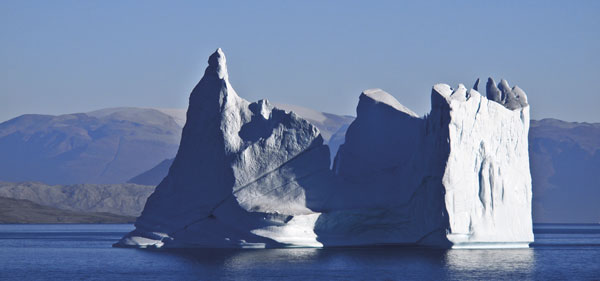A voyage on a research vessel to one of the most unaffected sea environments in the world: the expedition TUNU-V investigated how biological diversity in the fjords of north-eastern Greenland is affected by climate change.
By Nicklas Hägen
Photo: Erik Bonsdorff
North-eastern Greenland. On the tundra musk oxen wander around and among the ice bergs sharks of up to 450 years old are swimming. This land is virtually untouched by human beings. The sole sign of human activity is a solitary hut that fur hunters left behind in the first half of the twentieth century.
This wide expanse is the biggest national park in the world and about three times the size of all of Finland. The mountains are several kilometres high and treeless. Only the odd flower grows along the coast.
Erik Bonsdorff, Professor of Marine Biology at Åbo Akademi University, claims not to be a spiritual person, but he understands those who seek out areas like these in pursuit of spiritual experiences.
“One loses one’s sense of proportion. Everything is big and the sky is so crystal clear that a view of fifty kilometres is nothing. I asked the captain if we could not to take a little detour into a fjord, but the distance that I estimated to be two nautical miles turned out to be fourteen,” says Bonsdorff.
“When one is far away and there are no people around, one becomes very conscious of one’s vulnerability as an individual. If, for instance, you break a leg here you know that it will be a long time before you reach a hospital.”
Bonsdorff took part in the fifth TUNU expedition to the fjord landscape of the north-eastern coast of Greenland last August. The expedition was organised by Jørgen S. Christiansen, a professor at Tromsö University in Norway and visiting professor of marine biology at Åbo Akademi University for the academic year 2013–2014. The voyage was made by trawler, the FF Helmer Hanssen, from Tromsø via Jan Mayen and Greenland, up to Svalbard. The more than twenty researchers on the expedition represented half a dozen countries.
There is an ongoing conflict of economic and ecological values on the northern seas. As the climate warms the ice is shrinking, opening the area up to oil extraction and fishing – which themselves have further consequences for the environment.
Bonsdorff says that the Barents Sea between northern Norway, Svalbard and Novaja Zemlja is rapidly changing. So far the environments around Greenland’s north-eastern coast are among the most unaffected areas on the planet.
“But the area risks being damaged if the exploitation of resources continues to be uncontrolled. Areas such as this, are worth their weight in gold for the opportunities they provide for research and a thorough, fundamental knowledge of the arctic environment.”
The impact of climate change is already clear to see.
“Insight into what is at stake in climate change becomes crystal clear on an expedition like this. When you use your eyes you notice that the changes are happening fast and an entire ecosystem is at stake.”
The goal of the expedition was to find out how the species inhabiting the sea, with a focus on arctic fish, adapt to a changeable climate. The research is wide-ranging and varied. The existing species are described and environmental toxins, genetic factors, and physiology at a molecular level are investigated, as well as Bonsdorff’s own speciality, food webs. Geologists also took part in the expedition. They investigated the palaeo-climate, which pertained before there was any access to meteorological instruments, and charted the spread of inland ice during the most recent ice age.
In the Antarctic waters, the cold water around the pole forms a barrier between such organisms that are solely adapted to the cold water and the ones that live in somewhat warmer waters. The waters of eastern Greenland, however, offer considerably greater variation. At the bottom, temperatures may even go down to levels of below zero degrees, whereas up at the surface the water the temperature may rise up to ten degrees in places.
Moreover, when more water comes from the accelerating melting of the glaciers, above all in summer, the surface water is sweet. These variations require special adaptations in the organisms which inhabit these waters.
Because of the unique environment, the authorities take a negative attitude to humans landing. Only once did the expedition touch solid ground. The stay at the Danish research station, Zackenberg, in Greenland, was brief, as one of the Zodiacs suffered sea damage and with both polar bears and musk oxen having been previously sighted in the area the group was not able to stay on the beach without backup.
“This entire area is a national park and you have to be extremely careful not to harm the environment. For instance, we were not allowed to take samples without the authorities’ permission, and the leader of the expedition stayed in daily contact with them. Trawling was permitted for fifteen minutes at a time,” says Bonsdorff.
“When a similar expedition was mounted in the year 2003, trawling was carried out in one of the fjords we visited on this trip. With a very sensitive sonar we found tracks from the trawler on the bottom of the fjord. Changes happen that slowly in these environments.”Among the most exotic things they got in their nets were Greenland sharks, a slow and rather indolent species which may live for as long as 450 years.
“They eat just about anything and in one stomach we found, for instance, the remains of a seal cub. The individuals we caught were between two and four metres tall and between 75 and 350 years old. Some of them were here as far back as as the pre-industrial era, but will suffer from the consequences of the industrial age.”
Two weeks on board a sea trawler along the coast of Greenland involves shared cabins, constant daylight, and occasionally rough seas. Before the expedition reached Jan Mayen the waves were between six and eight metres high.
The journey was exhausting but well worthwhile.
“Research should not always be done for reasons of utility, in real time. The principle of curiosity is also important. The single greatest experience I have had of the nature here was probably coming to Jan Mayen in the middle of the night and noticing the perfectly-shaped cone of this vulcano sticking up out of nothing, in light conditions in which it was just about possible to take pictures,” says Bonsdorff.
– Everybody was incredibly tired when we landed on Svalbard. This was partly to do with the sea; the waves are exhausting. Partly it was because one gets too little sleep when every opportunity is seized for taking samples, and you want to experience all the natural features you can. This makes all the researchers stand on deck, for example, to see if one catches sight of any sharks. This is good for unity on board and it increases the levels of understanding across the disciplines within an international research team.



